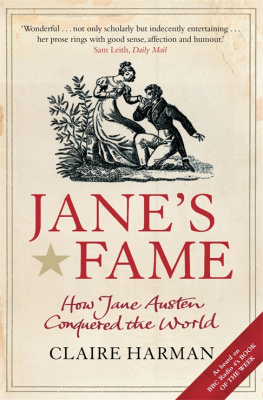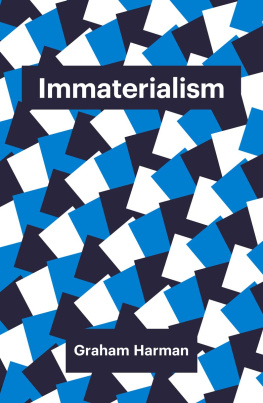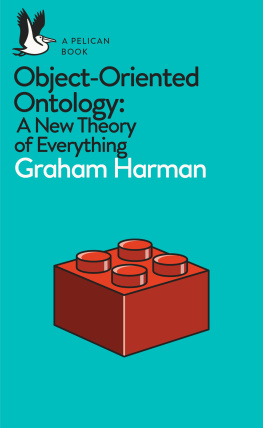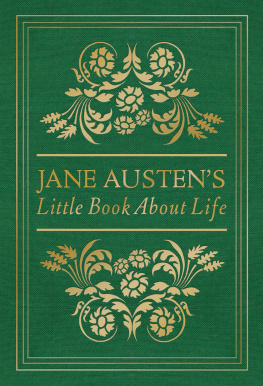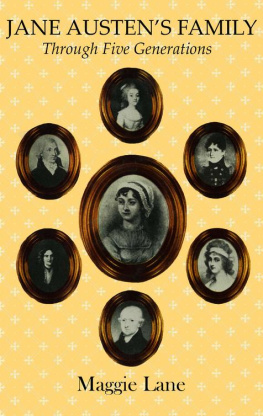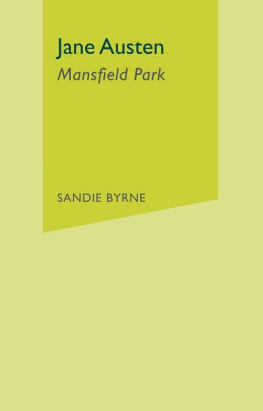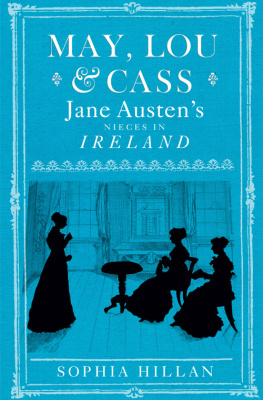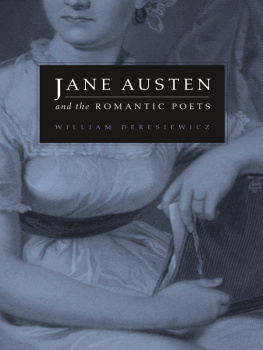1. Manuscript of Sir Charles Grandison by Jane Austen (kind permission of Chawton House Library, Hampshire www.chawtonhouse.org).
2. The Revd George Austen (17311805).
3. Letter from Revd George Austen to Thomas Cadell, 1 November 1797 (by kind permission of the President and Scholars of Saint John Baptist College in the University of Oxford).
4. John Murray II, mezzotint after unknown artist, early 1800s ( National Portrait Gallery, London).
5. Royalty cheque from the firm of John Murray to Jane Austen, 1816 (John Murray Archive Trustees of the National Library of Scotland).
6. Portrait of a man said to be the Revd James Stanier Clarke, LLD, FRS (17651834) by John Russell (17451806), c. 1790 ( V&A Images/Victoria and Albert Museum).
7. Silhouette of Cassandra Austen (17731845), undated (Jane Austen Memorial Trust).
8. Henry Austen (17711850), miniature c. 1820 (in family possession).
9. Jane Austens gravestone in Winchester Cathedral ( The Dean and Chapter of Winchester).
10. Richard Bentley, lithograph by Charles Baugniet, 1844 ( National Portrait Gallery, London).
11. Title page of Sense and Sensibility, published by Richard Bentley & Co. in 1833.
12. James Edward Austen-Leigh (17981874), artist unknown (Jane Austen Memorial Trust).
13. Robert William Chapman, bromide print by Walter Stoneman, 1949 ( National Portrait Gallery, London).
14. Chawton Cottage, photographed for The Bookman, January 1902 (The Bodleian Library, University of Oxford, Per 25805 c.2).
15. Dorothy Darnell and T. E. Carpenter at Chawton Cottage, late 1940s (Jane Austen Memorial Trust).
16. Jane Austen, pencil and watercolour drawing by Cassandra Austen, c.1810 ( National Portrait Gallery, London).
17. Watercolour painting by James Andrews after Cassandra Austen, 1869 (private family collection).
18. Engraving after Cassandra Austen; the frontispiece to James Edward Austen-Leighs Memoir of Jane Austen, 1870 ( Bettman/Corbis).
19. Steel engraving from Evert A. Duyckincks Portrait Gallery of Eminent Men and Women, 1873, artist unknown.
20. Silhouette, said to be of Jane Austen, artist unknown (Patrick OConnor Collection).
21. Mr and Mrs Bennet from Pride and Prejudice, Allen and Macmillan, 1894; illustration by Hugh Thomson.
22. Jane Austen, woodcut by Flix Vallotton, from La Revue Blanche, January-April, 1898.
23. Lithograph portrait of Flix Fnon by Maximilien Luce, from Mazas, 1894 ( ADAGP, Paris and DACS, London 2009).
24. Cover of The Storyteller, May 1924 (The Bodleian Library, University of Oxford, Per 2561 d.46).
25. Cartoon from Real Life Stories: Jane Austen, Girl 20 October 1954, drawn by Eric Dadswell ( IPC Magazines).
26. Royal Mail commemorative stamps, 1975, designed by Barbara Brown.
27. Greer Garson and Laurence Olivier in Robert Z. Leonards Pride and Prejudice, 1940 ( Turner Entertainment Co. A Warner Bros Entertainment Company. All rights reserved).
28. James McAvoy and Anne Hathaway in Becoming Jane,2007 (Source: BFI).
29. Jane Austen, 1995 ( Theo Westenberger/Corbis).
What is all this about Jane Austen? What is there in her?
What is it all about?
Joseph Conrad to H. G. Wells, 1901
When Jane Austens brother Henry wrote the first Biographical Notice about the author for the posthumous publication of Northanger Abbey and Persuasion in 1818, he clearly thought his would be the last words on the subject. Short and easy will be the task of the mere biographer, he wrote. A life of usefulness, literature and religion was not by any means a life of event. As far as Henry and his siblings were concerned, the story of their sisters authorship was over. A few of her remaining letters were bequeathed as keepsakes to nephews and nieces, others were destroyed or forgotten, the books went out of print, and Janes generation of Austens aged and died secure in the belief that the publics curiosity about their sister such as it was had been satisfied.
But almost two hundred years and tens of thousands of books on Austen later, her fame and readership worldwide continue to grow. Her six completed novels are among the best-known, best-loved, most-read works in the English language. Practically over-looked and the editor of the lad-mag Nuts. As the title of one Austen blog has it, Jane Austen Shes Everywhere!, endlessly referenced and name-dropped and part of todays multinational, multilingual, multicultural single currency.
The use of Austens name knows no generic boundaries. Who else is cited with equal approval by feminists and misogynists, can be linked to nineteenth-century anarchism, twenty-first-century terrorism and the National Trust, forms part of the inspiration behind works as diverse as Eugene Onegin and Bridget Joness Diary? During the 2006 World Cup Final, some viewers may have been momentarily distracted from the foot-and head-work of Zinedine Zidane by the Phillips advert behind the French goal announcing Sense and Simplicity, while a recent article about possible infiltration of US educational programmes by terrorists was titled Osama Bin Laden a Huge Jane Austen Fan. The phrase Pride and Prejudice itself, sonorous, moralistic and nicely alliterative, has provided headline-writers with one of their readiest formulae, though, of course, Austens novel is rarely the subject of whatever follows; Test Match coverage, the stalemate in a steel strike, the fallout from an anti-Islamic newspaper article, or the description of Bob Woodwards latest book about the Bush administrations Iraq strategy: A Heady Mix of Pride and Prejudice Led to War. There is a long tradition of linking the phrase with public affairs;
If Pride and Prejudice is the representative Austen title, its opening sentence is one of the most frequently abused quotes in the language, second only to to be or not to be. Marjorie Garber has called it a cultural bromide and cited its forced use in articles on subjects as diverse as grape allergies, opera stars and restaurant services, as well as pieces about Austen and her books, of course.
Austens success as an infinitely exploitable global brand, or conceptual product, is everything to do with recognition and little to do with reading. The Victorian novelist Margaret Oliphant understood this at the very dawn of Janeism: The best judges have here, for once, done the office of an Academy, she wrote in September 1870, suspicious of the fuss around the first biography, [they have] laureated a writer whom the populace would not have been likely to laureate, but whom it has learned to recognise. The universality of applause which Austen had already excited seemed
But unlike many candidates for global celebrity, Austen is a genuinely great artist as well as a popular one, an example of high culture in its least challenging form at once formidable and non-threatening, as the critic Claudia Johnson has said. fulfils every requirement of romance and erotic fantasy literature, but also contains matter for a lifetimes rumination on relations between the sexes. Her clear prose style is extraordinarily accessible, while her irony allows illimitable interpretation.
Austens appeal has been powerful enough to threaten the jurisdiction of critics, and certainly of literary critics. She is one of few writers who inspire personal love and strong feelings of proprietorship. Virginia Woolf observed that Austens characters are so rounded and substantial that readers treat them as if they were living people, The Web-connected world allows full indulgence of readers identification with the author and her works; there are hundreds of Austen blogs and sites, Austen Addicts, Lost in Austen, AustenProse (A daily celebration of the brilliance of Jane Austens writing) and The Republic of Pemberley, a heavily ironised zone that promises, rather unnecessarily, to be your haven in a world programmed to misunderstand all things Austen. In the blogosphere, Austens novels are valued as self-help literature and dating aids (a popular interactive quiz is Which Austen Heroine are You?) and it is easy to imagine that there are plenty of contented readers doing what the characters in Karen Joy Fowlers hit novel

